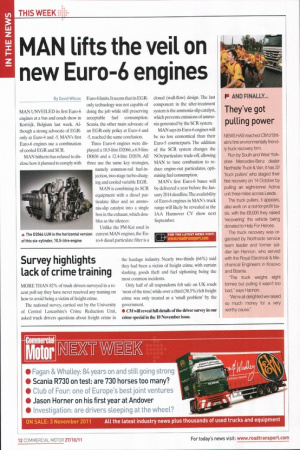Congestion
Page 12

Page 13

If you've noticed an error in this article please click here to report it so we can fix it.
takes its toll
Having announced a price rise, the results of a consultation on anti-congestion measures at the Dartford Crossing are due from the government (DfT) before Christmas. Ahead of this, operators reveal their views on an overcrowded system
Words: Simon Jack
THE DARTFORD-Thurrock Crossing is one of the worst pinch-points on the UK’s road system, but with no realistic alternatives when crossing the Thames to the east of London, operators have to endure long waits and, by spring 2012, a 60% increase in charges.
The crossing has expanded capacity over the years, but in its current form it was designed to handle 135,000 vehicles a day, a number that was exceeded on 257 days in 2010, according to oficial igures. The daily average in 2010 was 139,545 vehicles, with a peak of 171,371.
This is easily enough for even minor accidents to cause widespread disruption, according to Colin McKay, MD of Sittingbourne-based Fast Forward International. “The price increase is a slap in the face when no one seems able to sort out the problems. Whenever anything happens there is very quickly a huge delay,” he says.
Roger Wood, MD of Thamesmeadbased Ketra Logistics, adds: “The situation is diabolical. The system is vastly overpriced and doesn’t work.” In March 2011, the average speed on the section of the M25 approaching and containing the crossing, from Junctions 7 to 30, was 49.7mph southbound and 48.8mph northbound, according to Department for Transport igures. On the slowest 10% of journeys this fell to 33.9mph and 28.9mph.
Quite how things have got so bad is a matter of debate. The Freight Transport Association’s (FTA) head of road network management Malcolm Bingham argues: “Insuficient capital investment in infrastructure is the root cause of the problem.” Richard Newbold, chief executive of Tilbury-based Triple A Transport Serv ices, believes the simple fact that vehicles slow down for the toll is the main dificulty. “If trafic lowed straight through or over it, it would be like any other part of the M25,” he says.
The government conducted a consultation, ending on 23 September, into a series of anti-congestion measures and is due to announce its conclusions within three months. Its plans include suspending charges at times of heavy congestion; introducing ‘free-lowing’ electronic payment; and expanding crossing capacity.
However, it intends to fund these changes with a price hike, to be introduced in two stages by next spring, from £2 to £3 for two-axle goods vehicles and from £3.70 to £6 for multi-axle vehicles – the crossing is free from 10pm to 6am.
Many hauliers say the increase will add to an onerous burden. Essex-based Online Roadways sends 300 trucks a week through the crossing. Fleet manager Ray Fenton says: “The cost comes straight out of the back pocket of the company, but we are seeing nothing for it.”
A double whammy
Newbold says there are two costs: the charges themselves and the delays for queuing. “It is a double whammy, but it is not something you can charge the customer for.” Industry bodies raised their concerns about the price increases in their consultation responses. The Road Haulage Association (RHA) says the way to beat congestion would be to remove the tolls completely, although it recognises this is unlikely. Infrastructure manager Chrys Rampley says: “We were promised that when the bridge was completed the tolls would come off but it never happened.” The FTA argues that charges should increase only once improvements have been introduced. “It is wholly unfair to introduce a road charge designed to de ter trafic on those who have no choice but to use the crossing,” says Bingham.
The government hopes that in the medium term ‘free-lowing’ payment, which it wants to introduce by the end of 2013, will reduce bottlenecks. This would involve new payment methods for preregistered users, physical lay-out changes and using automatic number plate recognition cameras.
The FTA believes short-term measures are also needed. It would like to see motorists encouraged to use the DART-Tag system by freezing charges for those who do. Users load pre-payments onto their tag, which is kept inside the windscreen and causes the barriers to open automatically.
In the longer term, the government is planning to increase crossing capacity and plans to assess three possibilities over the next 12-18 months. These would include increased capacity at the existing crossing, or a new crossing either east or west of Gravesend and Tilbury.
The FTA and RHA want money raised at the crossing to be ring-fenced for this purpose, but many hauliers are sceptical about when another crossing would be built.
McKay says: “I don’t believe it will happen in the foreseeable future, not with the economy in the state it’s in.” n
FOR THE LATEST NEWS VISIT:
www.roadtransport.com














































